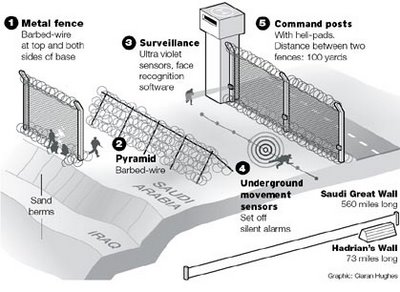The Saudi's Immigrant-hunting Border Fence (the nomadic fortress part 2)

[Image: Map of proposed Saudi border fence along Iraq border. From Saudis build 550-mile fence to shut out Iraq, 01/10/2006.]
With the utterly abysmal situation in Iraq, the Saudi government now sees it as imperative to build a security fence along its 560 mile stretch of northern frontier, which is essentially a barren desert patrolled right now at best, according to this article, by 100 sniffer-dog teams. While it is not clear whether the fence would stretch the entire distance along the border or just at key crossing points, the $500m upgrade will surely bring their project comparisons to other border precedents around the world, namely the Israeli security barrier, the massive migration fence in southern Spain, and potentially the next phase of wall-building along 700 miles of the U.S./Mexico border.
This hi-tech ‘state-of-the-art’ Saudi barrier would typically have a double fence running 100 yards apart with 135 electronically controlled gates, fence-mounted movement detection sensors, a web of buried radio detection sensor cables tendriling under a hotbed of baking sand, and will also combine an array of ultraviolet night-vision cameras with face-recognition software processesing and relaying pictures back to a network of new security bases with heliports and dispatch patrols, not to mention a few new sand berms and thousands of miles of razor barbed wire. With all of that, it is suprising the fence won’t be electrified.

[Image: From Saudis Plan Fence Along Iraq Border, published on 9/28/2006.]
This is all part of a larger centralized and more sophisticated security plan which is bracing for anotheer type of attack: a potential “blowback” from Iraq, you know, just in case it gets worse. And, tragically enough, it probably can and will. This article states, “they are mostly concerned that an Iraqi civil war will send a wave of refugees south, unsettling the kingdom's Shia minority in its oil-producing east,” as well as a new invasion of militant insurgents that would pour into their country. However, Time magazine makes this simple point: This fence “will not ensure Saudi Arabia's security. The kingdom has had at least five deadly terrorist attacks since 2003, and some of the perpetrators were homegrown.”
More alarming, however, is this claim in The Telegraph:
For Saudi Arabia, terrorists and refugees from the conflict are not the only unwelcome intruders.
"We suffer badly from illegal immigration, as well as the smuggling of drugs, weapons and even prostitutes," said Mr Obaid. "It is becoming a major issue."
Despite the details emerging about the fence, Saudi Arabia's military is keeping some aspects under wraps. According to one source, the project is being kept so secret that military officials from Centcom, America's central command responsible for Iraq, have been told they cannot inspect the site on "national security" grounds.
Even spy satellites will not be able to unravel the fence's secrets. The source speculated that the reason for the secrecy might be automated weapons systems attached to the fence that could fire on suspected smugglers or intruders.
"It's being done in true Saudi style," the source said. "State-of-the-art equipment and no expense spared."

[Image: A Saudi barrier is seen at the border line with Yemen. From Riyadh halts work on border barrier with Yemen, 2004.]
At the southeastern corner of the Saudi Arabian Peninsula, meanwhile, Yahoo News reports, the United Arab Emirates is building a barrier along its border with Oman.
An so, with the fall of the Berlin Wall it seems a whole new era of border fence construction has emerged in its place; a globalized spawn of separation walls insinuating themselves across the entire geopolitical landscape. What if they connected, literally, from the Korean DMZ to the Great Wall of China, snaking piecemeal sections of separation barrier on down to join the fence taking shape in Kashmir, continuing with even more fortification between Pakistan and India, and over to India/Bangladesh, falling even further south to catch up to the increasingly militarized boundary line stretching between Thailand, Malaysia and Burma; then, disappearing momentarily from radar only to ressurect in the Middle East, snaking up through Kyrgyzstan/Uzbekistan and eastern Europe, Padua, Italy, resting lazily between Russia Poland and Germany, with another segmented torso piece swelling along the strait of Gibraltar, scribling through a messy tangle of borders through out Africa emanating in a 10' electric fence between Botswana and Zimbabwe....all the missing segments carried on by an implicit line, so that eventually this massive barrier is stretched west whereby it mysteriously attaches itself once again to the scrappy disputed border fence mocking the border of U.S. and Mexico.
All the world's separation barriers joining together in a hegemonic solidarity of geopolitical exclusion, a global fortress wall isolating the developing world from the ranks of upwardly mobile integration. I wonder, if a single security fence connected all of these borderzones together and became visible from space, like some militarized architectural python preparing itself for a great global squeeze, how a geographic depiction of globalization might look then, all that "borderless" hyperbole dispelled and distilled into virtually two separate globally distorted continents? Imagine if this universal security fence were actually armed with a uniform hi-tech defensive camera and mounted-gun system (as the Saudi fence mystery alludes), imagine if this leviathan border fence one day became intelligent, autonomous, mobile, even, erasing territorial boundaries and violating national sovereignties all on its own with a single sweep of its modular and flexible architectonic tail?
Is it the future of architectural occupation, automated geoannexation, the grand device of the empire's new eminent domain campaign? The entire Third world turned into a globally fragmented detention center? A self-enclosing nomadic prison?
More likely just another delusion of my warped subtopian obsession with the military's hostile architectural takeover of the world. So then, move along, nothing to see here.
See: Globalization of Forced Migration, and the nomadic fortress (part 1)
1 Comments:
See "Israel's security barrier works"
Post a Comment
<< Home